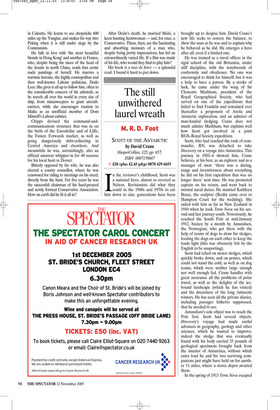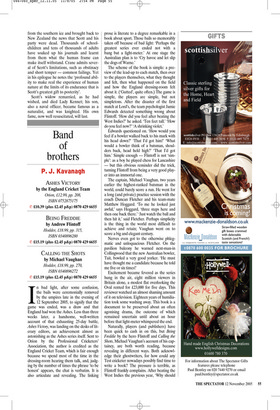The still unwithered laurel wreath
M. R. D. Foot
SCOTT OF THE ANTARCTIC by David Crane HarperCollins, £25, pp. 657, ISBN 0007159687 ✆ £20 (plus £2.45 p&p) 0870 429 6655 In the reviewer’s childhood, Scott was a national hero, almost as revered as Nelson. Revisionists did what they could in the 1960s and 1970s to cut him down to size; generations have been brought up to despise him. David Crane’s new life seeks to restore the balance, to show the man as he was and to explain why he behaved as he did. He emerges a hero after all, even if a limited one.
He was trained as a naval officer in the rigid school of the old Britannia, under stiff discipline, with the watchwords of conformity and obedience. No one was encouraged to think for himself; but it was a help to have a patron. By a stroke of luck, he came under the wing of Sir Clements Markham, president of the Royal Geographical Society, who had served on one of the expeditions that failed to find Franklin and remained ever thereafter a proponent of Arctic and Antarctic exploration, and an admirer of man-hauled sledging. Crane does not much admire Markham, but explains well how Scott got involved in a joint RGS–Royal Society expedition.
Scott, who had reached the rank of commander, RN, was detached to take Discovery on a voyage into Antarctica. This journey in 1901–4 showed him, Crane believes, at his best, as an explorer and as a manager of men: ‘there was a daring, range and inventiveness about everything he did on his first expedition that was no longer there’ next time. He was promoted captain on his return, and went back to normal naval duties. He married Kathleen Bruce, the sculptor (Rodin came over to Hampton Court for the wedding). She sailed with him as far as New Zealand in 1910 when he took Terra Nova on his second and last journey south. Notoriously, he reached the South Pole in mid-January 1912, beaten by a month by Amundsen, the Norwegian, who got there with the help of teams of dogs to draw his sledges, feeding the dogs on each other to keep the loads light (this was obscurely felt by the English to be unsporting).
Scott had relied on motor sledges, which quickly broke down, and on ponies, which could not stand the cold, as well as on dog teams, which were neither large enough nor well enough fed. Crane handles with great assurance all the problems of polar travel, as well as the delights of the icebound landscape (which he has visited) and the dreariness of the long Antarctic winters. He has seen all the private diaries, including passages hitherto suppressed, that he needed to see.
Amundsen’s sole object was to reach the Pole first. Scott had several objects. Discovery’s voyage had made useful advances in geography, geology and other sciences, which he wanted to improve; indeed the sledge that was eventually found with his body carried 35 pounds of geological specimens brought back from the interior of Antarctica, without which extra load he and his two surviving companions just might have held on for another 11 miles, where a stores depot awaited them.
In the spring of 1913 Terra Nova escaped from the southern ice and brought back to New Zealand the news that Scott and his party were dead. Thousands of schoolchildren and tens of thousands of adults have soaked up his journals and learnt from them what the human frame can make itself withstand. Crane admits several of Scott’s limitations, such as obstinacy and short temper — common failings. Yet in his epilogue he notes the ‘profound ability to make real the experience of human nature at the limits of its endurance that is Scott’s greatest gift to posterity’.
Scott’s widow remarried, as he had wished, and died Lady Kennet; his son, also a naval officer, became famous as a naturalist, and was knighted. His own fame, now well resuscitated, will last.




























































 Previous page
Previous page